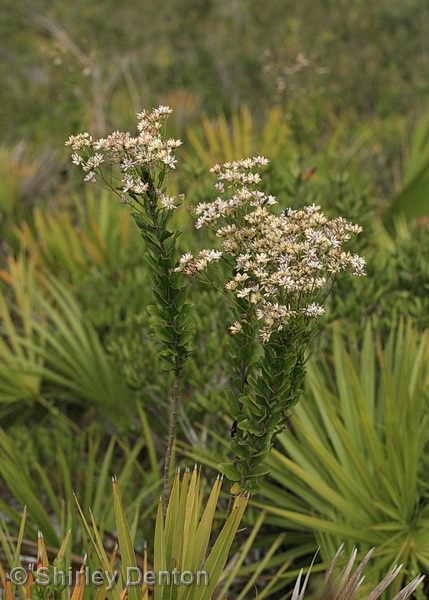Difference between revisions of "Palafoxia feayi"
KatieMccoy (talk | contribs) (→Taxonomic notes) |
KatieMccoy (talk | contribs) (→Distribution) |
||
| Line 27: | Line 27: | ||
==Distribution== | ==Distribution== | ||
| + | ''P. feayi'' is endemic to the southern two thirds of the Florida peninsula<ref name="hawthorn"/>. | ||
| + | |||
==Ecology== | ==Ecology== | ||
===Habitat=== <!--Natural communities, human disturbed habitats, topography, hydrology, soils, light, fire regime requirements for removal of competition, etc.--> | ===Habitat=== <!--Natural communities, human disturbed habitats, topography, hydrology, soils, light, fire regime requirements for removal of competition, etc.--> | ||
Revision as of 14:30, 15 February 2016
| Palafoxia feayi | |
|---|---|

| |
| Photo by Shirley Denton (Copyrighted, use by photographer’s permission only) Nature Photography by Shirley Denton | |
| Scientific classification | |
| Kingdom: | Plantae |
| Division: | Magnoliophyta - Flowering plants |
| Class: | Magnoliopsida – Dicotyledons |
| Order: | Asterales |
| Family: | Asteraceae ⁄ Compositae |
| Genus: | Palafoxia |
| Species: | P. feayi |
| Binomial name | |
| Palafoxia feayi A. Gray | |

| |
| Natural range of Palafoxia feayi from USDA NRCS Plants Database. | |
Common name: Feay's palafox
Contents
Taxonomic notes
The genus Palafoxia is named after Jose de Palafox y Melci a spanish captian-general, well known in the Peninsular War. The species is named for William T. Feay, who was an avid plant collector in the southeast[1].
Description
A description of Palafoxia feayi is provided in The Flora of North America.
Distribution
P. feayi is endemic to the southern two thirds of the Florida peninsula[1].
Ecology
Habitat
In the Coastal Plain in Florida, P. feayi can occur in oak-palmetto-Lyonia scrubs, sand pine scrubs, and pine/palmetto scrubs (FSU Herbarium). It has also been observed growing with Bigelowia nuttallii in sandbur-natal grass in an open sand pine remnant. Associated species include Bigelowia nuttallii, Serenoa repens, Pinus clausa, natalgrass, sandbur, and oak species (FSU Herbarium)
Phenology
Flowers July through December (FSU Herbarium).
Seed dispersal
Seed bank and germination
Fire ecology
It has been observed growing in a burned scrub (FSU Herbarium).
Pollination
The following Hymenoptera families and species were observed visiting flowers of Palafoxia feayi at Archbold Biological Station (Deyrup 2015):
Apidae: Apis mellifera, Bombus impatiens
Colletidae: Colletes thysanellae
Halictidae: Agapostemon splendens, Augochlorella aurata, Augochloropsis sumptuosa, Halictus poeyi, Lasioglossum pectoralis, L. placidensis
Megachilidae: Anthidiellum perplexum, Coelioxys sayi, Megachile albitarsis, M. brevis pseudobrevis, M. georgica, M. inimica, M. mendica, M. petulans, M. policaris, M. texana, M. xylocopoides
Pompilidae: Episyron conterminus posterus
Sphecidae: Ammophila urnaria, Tachytes pepticus
Vespidae: Parancistrocerus perennis anacardivora, Zethus slossonae, Z. spinipes
Use by animals
Diseases and parasites
Conservation and Management
Cultivation and restoration
Photo Gallery
Flowers of Palafoxia feayi Photo by Shirley Denton (Copyrighted, use by photographer’s permission only) Nature Photography by Shirley Denton
References and notes
Deyrup, M.A. and N.D. 2015. Database of observations of Hymenoptera visitations to flowers of plants on Archbold Biological Station, Florida, USA.
Florida State University Robert K. Godfrey Herbarium database. URL: http://herbarium.bio.fsu.edu. Last accessed: October 2015. Collectors: Loran C. Anderson, D. Burch, George R. Cooley, R.J. Eaton, Robert K. Godfrey, R. Kral, Olga Lakela, S.W. Leonard, Victoria Sullivan, D.B. Ward. States and Counties: Florida: Brevard, Collier, Highlands, Indian River, Lake, Manatee, Marion, Pinellas, Polk. Compiled by Tall Timbers Research Station and Land Conservancy.
